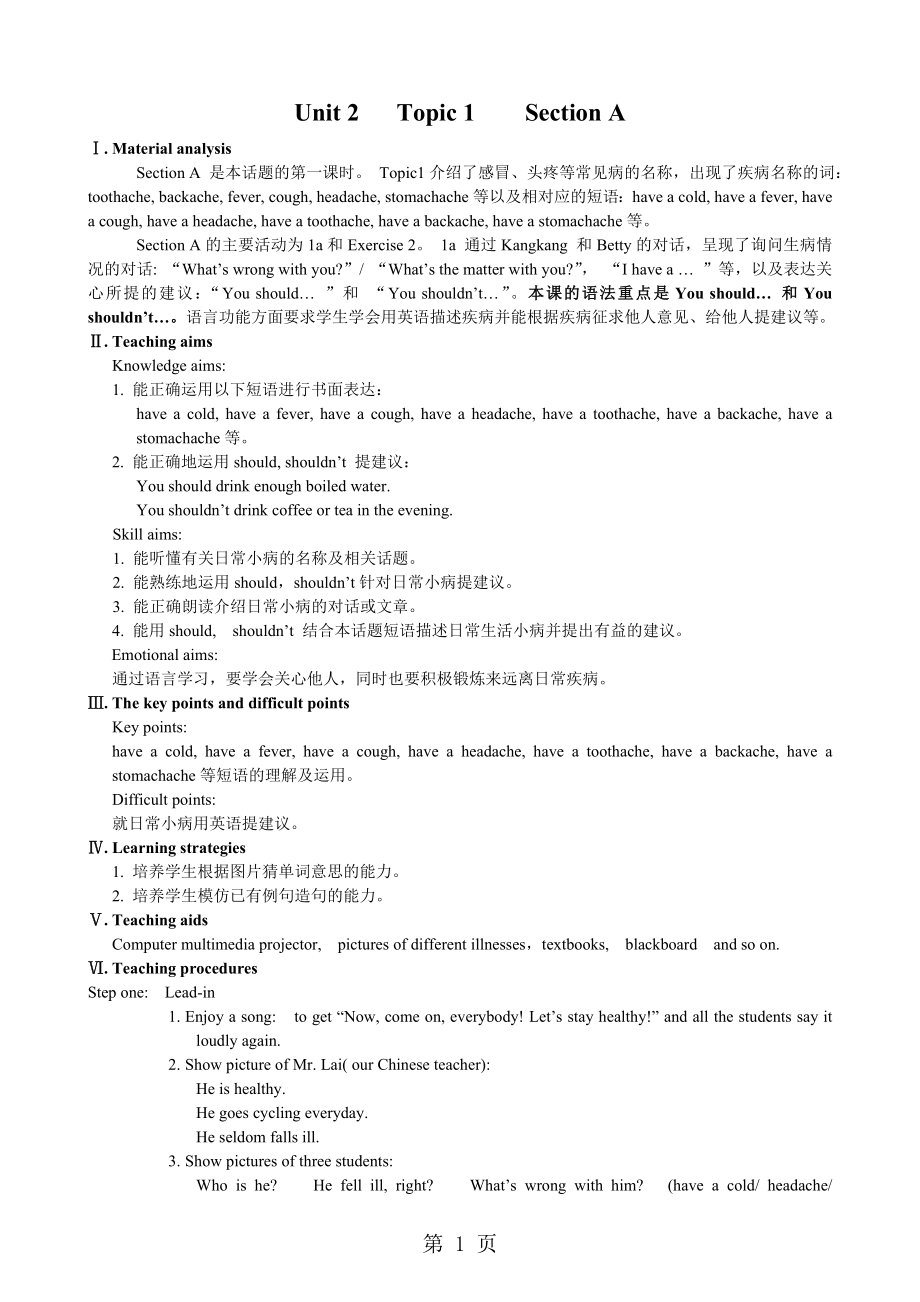《仁愛英語八年級(jí)上冊(cè)u(píng)nit2topic1sectiona教案》由會(huì)員分享�����,可在線閱讀,更多相關(guān)《仁愛英語八年級(jí)上冊(cè)u(píng)nit2topic1sectiona教案(3頁珍藏版)》請(qǐng)?jiān)谘b配圖網(wǎng)上搜索���。
1�����、Unit 2 Topic 1 Section A. Material analysis Section A 是本話題的第一課時(shí)�。 Topic1介紹了感冒���、頭疼等常見病的名稱���,出現(xiàn)了疾病名稱的詞:toothache, backache, fever, cough, headache, stomachache等以及相對(duì)應(yīng)的短語:have a cold, have a fever, have a cough, have a headache, have a toothache, have a backache, have a stomachache等。 Section A的主要活動(dòng)為1a和Exerc
2�、ise 2。 1a 通過Kangkang 和Betty的對(duì)話�����,呈現(xiàn)了詢問生病情況的對(duì)話: “Whats wrong with you?”/ “Whats the matter with you?”�����, “I have a ”等����,以及表達(dá)關(guān)心所提的建議:“You should ”和 “You shouldnt”��。本課的語法重點(diǎn)是You should 和You shouldnt��。語言功能方面要求學(xué)生學(xué)會(huì)用英語描述疾病并能根據(jù)疾病征求他人意見���、給他人提建議等。. Teaching aimsKnowledge aims:1. 能正確運(yùn)用以下短語進(jìn)行書面表達(dá):have a cold, have a fev
3�����、er, have a cough, have a headache, have a toothache, have a backache, have a stomachache等�����。2. 能正確地運(yùn)用should, shouldnt 提建議:You should drink enough boiled water.You shouldnt drink coffee or tea in the evening. Skill aims:1. 能聽懂有關(guān)日常小病的名稱及相關(guān)話題���。2. 能熟練地運(yùn)用should,shouldnt針對(duì)日常小病提建議���。3. 能正確朗讀介紹日常小病的對(duì)話或文章���。4. 能用sh
4���、ould, shouldnt 結(jié)合本話題短語描述日常生活小病并提出有益的建議。Emotional aims:通過語言學(xué)習(xí)��,要學(xué)會(huì)關(guān)心他人���,同時(shí)也要積極鍛煉來遠(yuǎn)離日常疾病�。. The key points and difficult pointsKey points:have a cold, have a fever, have a cough, have a headache, have a toothache, have a backache, have a stomachache等短語的理解及運(yùn)用���。 Difficult points:就日常小病用英語提建議��。. Learning strat
5��、egies1. 培養(yǎng)學(xué)生根據(jù)圖片猜單詞意思的能力���。2. 培養(yǎng)學(xué)生模仿已有例句造句的能力。. Teaching aids Computer multimedia projector, pictures of different illnesses���,textbooks, blackboard and so on. Teaching proceduresStep one: Lead-in1. Enjoy a song: to get “Now, come on, everybody! Lets stay healthy!” and all the students say it loudly aga
6��、in.2. Show picture of Mr. Lai( our Chinese teacher):He is healthy.He goes cycling everyday.He seldom falls ill.3. Show pictures of three students:Who is he? He fell ill, right? Whats wrong with him? (have a cold/ headache/ toothache.)Step two: Presentation1. New words/phrases: have a (backache/ stom
7���、achache/cough/ fever.)2. Sentences: Whats wrong with? / Whats the matter with? 3. Practice: Fill in the blanks ( to review different kinds of illnesses) Listen and number the picture. ( Deal with 1C on Page27) Guess: to ask and answer different kinds of illnesses. Memory games: “I say, you do” “I ac
8�����、t, you guess” “One student acts, Others guess.”4. Sentences: I have a toothache: I should see a dentist at once. / I shouldnt eat too much candy. I have a headache: You should have a good sleep. / You shouldnt stay up late.5. Practice: Work alone. ( to finish Exercise2 on Page28) And show some pictu
9�����、res to strengthen the expressions: “boiled water, coffee, tea, lift heavy things.”Step three: Listening-task Listen to 1a carefully to finish 1bStep four: Reading-task Whole-class reading Role-play readingStep five: Production Ss work in groups , make a survey, and give advice Ss work in groups, mak
10����、e new conversations according to the survey, and then act out in front of class. Creative-work: Look at pictures and give suggestions to these classmates as more as possible.宋以后����,京師所設(shè)小學(xué)館和武學(xué)堂中的教師稱謂皆稱之為“教諭”。至元明清之縣學(xué)一律循之不變��。明朝入選翰林院的進(jìn)士之師稱“教習(xí)”���。到清末,學(xué)堂興起�,各科教師仍沿用“教習(xí)”一稱。其實(shí)“教諭”在明清時(shí)還有學(xué)官一意�����,即主管縣一級(jí)的教育生員。而相應(yīng)府和州掌管教育生員
11����、者則謂“教授”和“學(xué)正”?���!敖淌凇薄皩W(xué)正”和“教諭”的副手一律稱“訓(xùn)導(dǎo)”。于民間���,特別是漢代以后�����,對(duì)于在“?��!被颉皩W(xué)”中傳授經(jīng)學(xué)者也稱為“經(jīng)師”。在一些特定的講學(xué)場(chǎng)合�,比如書院、皇室�,也稱教師為“院長、西席�����、講席”等。Step six: Emotional Aim We should do more exercise to keep away from illnesses.Step seven: Summary/ Conclusion Summarize the key points on the blackboard. Conclude which group is the best one
12��、. Blackboard designUnit 2 Topic 1 Section ANew words Sentence Patterns Othershave a headache Whats wrong with you? drink coffee or teahave a toothache I have a toothache. lift heavy thingshave a backache drink enough boiled waterhave a stomachache Whats the matter with him/her? have a cold He/She ha
13��、s a toothache. get wellhave a cough have a fever You should see a dentist. You shouldnt lift heavy things. I hope youll get well soon. 我國古代的讀書人,從上學(xué)之日起,就日誦不輟,一般在幾年內(nèi)就能識(shí)記幾千個(gè)漢字,熟記幾百篇文章,寫出的詩文也是字斟句酌,瑯瑯上口,成為滿腹經(jīng)綸的文人��。為什么在現(xiàn)代化教學(xué)的今天,我們念了十幾年書的高中畢業(yè)生甚至大學(xué)生,竟提起作文就頭疼,寫不出像樣的文章呢?呂叔湘先生早在1978年就尖銳地提出:“中小學(xué)語文教學(xué)效果差,中學(xué)語文畢業(yè)生語文
14�、水平低,十幾年上課總時(shí)數(shù)是9160課時(shí),語文是2749課時(shí),恰好是30%,十年的時(shí)間,二千七百多課時(shí),用來學(xué)本國語文,卻是大多數(shù)不過關(guān),豈非咄咄怪事!”尋根究底,其主要原因就是腹中無物。特別是寫議論文,初中水平以上的學(xué)生都知道議論文的“三要素”是論點(diǎn)�、論據(jù)、論證,也通曉議論文的基本結(jié)構(gòu):提出問題分析問題解決問題,但真正動(dòng)起筆來就犯難了����。知道“是這樣”,就是講不出“為什么”。根本原因還是無“米”下“鍋”���。于是便翻開作文集錦之類的書大段抄起來,抄人家的名言警句,抄人家的事例,不參考作文書就很難寫出像樣的文章���。所以,詞匯貧乏、內(nèi)容空洞��、千篇一律便成了中學(xué)生作文的通病���。要解決這個(gè)問題,不能單在布局謀篇等寫作技方面下功夫,必須認(rèn)識(shí)到“死記硬背”的重要性,讓學(xué)生積累足夠的“米”����。 Teaching Reflection:Its a little hard for the students to give proper suggestions on illnesses. They should practice more after class.第 3 頁
 仁愛英語八年級(jí)上冊(cè)u(píng)nit2topic1sectiona教案
仁愛英語八年級(jí)上冊(cè)u(píng)nit2topic1sectiona教案

